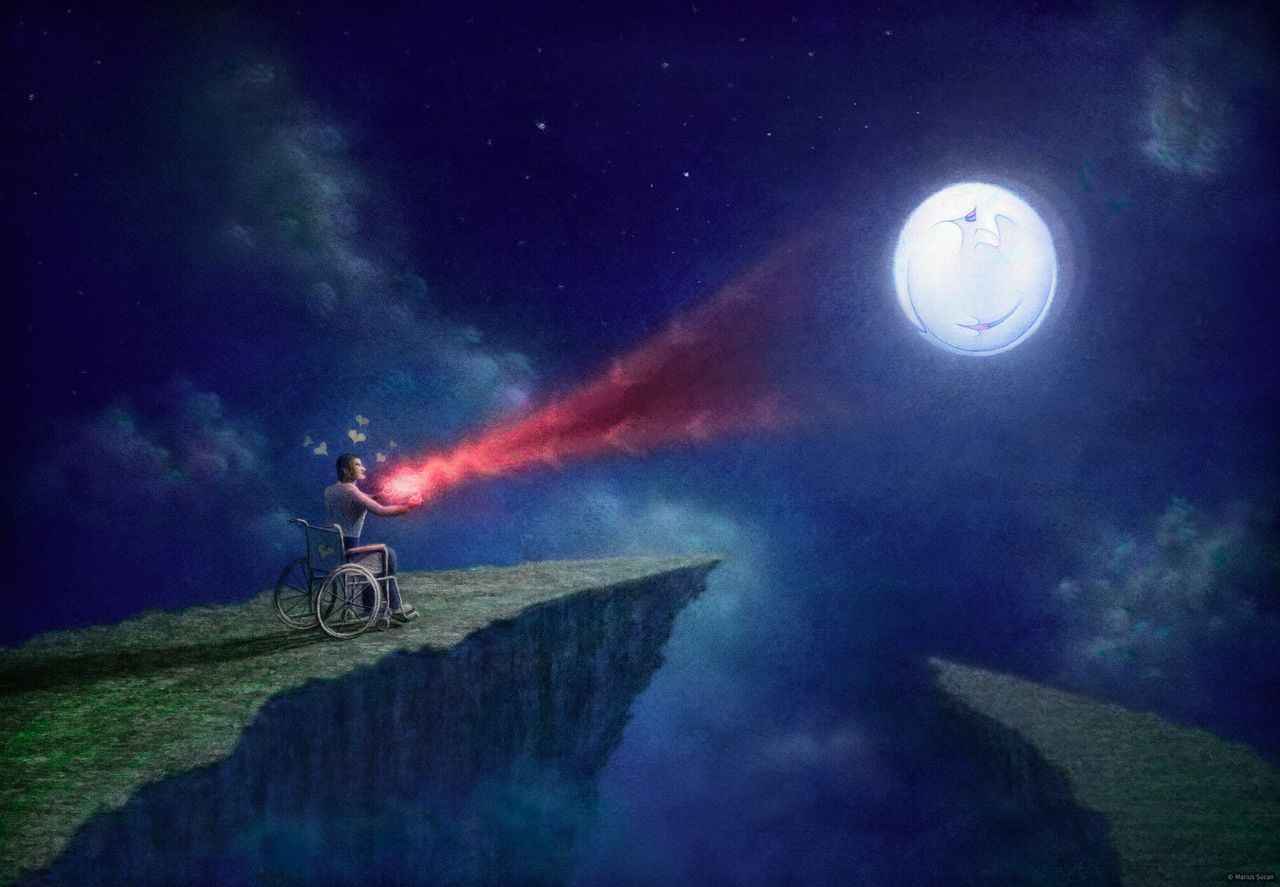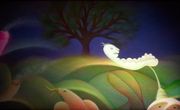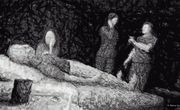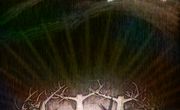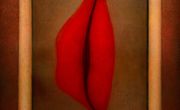The impossible capture
Created .
For this project I decided to represent the disabled men in their attempt to approach women and the difficulty of doing this. I made the picture to look childish, joyful and positive, with vivid and appealing colors. The less positive aspects of the image are concealed using anamorphosis.
In the foreground, I painted two rock peaks that climb toward the center of the image. On the left cliff, a disabled man in his wheelchair, is facing the sky. The background is a night sky with a few cloud formations. The sky is painted in dark blue tones. On the right side, I depicted a large full moon. The image evokes a romanticized atmosphere and an optimistic mood. The color palette is based on cool tones: dark blues. cyans and green accents for the cliffs.
The "action" I present in this image, is the attempt of the disabled person to communicate with the moon, to attract it towards himself, to persuade the moon to get closer. The overall pose and his orientation towards the moon, emphasize this. In his hands, I painted a source of light or power that he uses to attract the moon. I did not chose to illustrate a particular object or a tool to "capture" the moon, because I did not want to show that it is a physical activity. I suggest that it is an energy field that springs from his hands. I intend it to be a visual metaphor for something based on his mental and intellectual capacities or his emotional involvement in persuading the moon to come to him. The red color of the energy field might suggest his passion in this endeavor or the heat of the energy field itself.
We may also notice that the disabled person had to rise to the moon, to climb the highest cliffs to reach to it. In this way I suggest that he had to progress professionally, socially or on a personal level to accomplish his goals, in this case, to attract the moon and to persuade it to come to him. He is already situated at a very altitude high, on cliffs close to the sky. Up there, he is alone and sees nothing but the sky, the rocks and the moon. I stress out that he is alone in his pursuit or a lonely person. Or, it is a metaphor for how demanding women are and whatever a disabled man does, will never be enough to win a woman's heart.
To make this picture, I used as inspiration romantic clichés. Known are the silly stories in which the man does anything for his love: he takes her to the moon or he offers it as gift. These are obviously impossible things, but in this painting, something else is impossible. In this case, the main character does not try to steal the moon, to take it to his love. What the moon represents for him and his physical disabilities render impossible his pursuit.
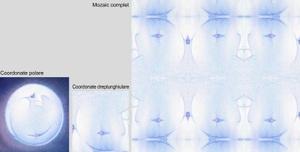 The moon is an anamorphic element. The moon is personified, it
has a face. In this picture, the moon represents Aphrodite, the
Ancient Greek goddess of love, pleasure and beauty. This visual element is meant to be a metaphor for the entire
female gender, for women. The disabled person is trying to attract the female gender, women. For him it is equally
impossible to do this as it is for the incurable lovers who want to give the moon as a gift to their loved one. Around
the head of the disabled person and on the back of the wheelchair, I painted several hearts to suggest that he is in
love with the opposite gender.
The moon is an anamorphic element. The moon is personified, it
has a face. In this picture, the moon represents Aphrodite, the
Ancient Greek goddess of love, pleasure and beauty. This visual element is meant to be a metaphor for the entire
female gender, for women. The disabled person is trying to attract the female gender, women. For him it is equally
impossible to do this as it is for the incurable lovers who want to give the moon as a gift to their loved one. Around
the head of the disabled person and on the back of the wheelchair, I painted several hearts to suggest that he is in
love with the opposite gender.
The moon is a picture painted in rectangular coordinates, but for the final image, it was transformed into polar coordinates. Thus, at first glance, we cannot easily guess what it is. I designed the original image in such a way that when it is transformed into polar coordinates, I obtained a weird face. To see the original image, the moon image must be converted back into rectangular coordinates. The original image of the moon is made up of half contours of multiple feminine private parts, drawn from different profiles and angles. Therefore, besides the coordinates conversion, to see the complete shapes of the female genitals I sketched, one must create a mosaic of the image obtained after conversion. To properly perform the coordinates transformation, the center of the circle and the matching diameter must be found. If these are not properly determined, you cannot get to see properly the shapes.
